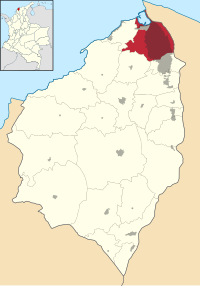
Back Barranquilla Afrikaans بارانكيا Arabic بارانكيلا ARZ Barranquilla AST Barranquilla AVK Barranquilla Aymara Barrankilya Azerbaijani Баранкілья Byelorussian Баранкиля Bulgarian Barranquilla Breton
Barranquilla | |
|---|---|
District and city | |
| Nickname(s): | |
| Motto(s): Ven vive Barranquilla ("Come and live Barranquilla") | |
 Atlántico Department | |
| Coordinates: 10°59′00″N 74°48′07″W / 10.98333°N 74.80194°W | |
| Country | |
| Region | Caribbean |
| Department | Atlántico |
| Established | April 7, 1813 |
| Government | |
| • Mayor | Alejandro Char(Radical Change) |
| Area | |
• District and city | 154 km2 (59.46 sq mi) |
| Elevation | 18 m (59 ft) |
| Population | |
• District and city | 1,206,319 |
• Estimate (2023)[3] | 1,327,209 |
| • Rank | ranked 4th |
| • Density | 8,618/km2 (22,320/sq mi) |
| • Urban | 1,326,588 |
| • Metro | 2,370,000 |
| Demonym | Barranquillero/a |
| GDP (PPP, constant 2015 values) | |
| • Year | 2023 |
| • Total | $29.8 billion[4] |
| Time zone | UTC-5 |
| Postal code | 080020 |
| Area code | 57 + 5 |
| Website | www |
Barranquilla (Latin American Spanish pronunciation: [baraŋˈkiʝa] ) is the capital district of the Atlántico department in Colombia. It is located near the Caribbean Sea and is the largest city and third port[5] in the Caribbean coast region; as of 2018, it had a population of 1,206,319[6][2] making it Colombia's fourth-most populous city after Bogotá, Medellín, and Cali.
Barranquilla lies strategically next to the delta of the Magdalena River, 7.5 km (4.7 mi) (originally 25 km (16 mi) before rapid urban growth) from its mouth at the Caribbean Sea, serving as a port for river and maritime transportation within Colombia. It is also the main economic center of the Atlántico department in Colombia. The city is the core of the Barranquilla metropolitan area, with a population of over 2 million, which also includes the municipalities of Soledad, Galapa, Malambo, and Puerto Colombia.
Barranquilla was legally established as a town on April 7, 1813, although it dates from at least 1629. It grew into an important port, serving as a haven for immigrants from Europe, especially during and immediately following World War I and World War II, when waves of additional immigrants from the Middle East and Asia arrived. Barranquilla became Colombia's main port, and with its level of industrialization and modernity, it earned the nickname "Colombia's Golden Gate" (Spanish: La Puerta de Oro de Colombia). In the 1940s, Barranquilla was the second-largest city in Colombia and one of the most modern cities in the Caribbean and in South America; later local administrations, due to widespread corruption in their ranks, brought about a decline in the standard of living. As government investment increased in other Colombian cities, Barranquilla's national position was eclipsed.
Barranquilla has hosted the 2018 Central American and Caribbean Games.[7][8] The city is home to one of the most important folk and cultural festivals of Colombia, the Carnival of Barranquilla, which was declared a National Cultural Heritage by the Congress of Colombia in 2001 and recognized by UNESCO in 2003.[9][10][11]
Ernesto Cortissoz International Airport, built in Barranquilla in 1919, was the first airport in South America. The city is served by domestic and international flights and was Avianca's first hub.
- ^ [1] Archived September 28, 2015, at the Wayback Machine (in Spanish)
- ^ a b "informacion-capital-DANE-2019" (PDF). DANE. dane.gov.co. p. 150. Archived December 29, 2019, at the Wayback Machine
- ^ "DANE – Proyecciones de población".
- ^ "TelluBase—Colombia Fact Sheet (Tellusant Public Service Series)" (PDF). Tellusant. Retrieved January 11, 2024.
- ^ "BOLETÍN ESTADÍSTICO TRÁFICO PORTUARIO EN COLOMBIA Año 2019" (PDF). Superintendencia de Transporte. supertransporte.gov.co. p. 46. Archived March 4, 2021, at the Wayback Machine
- ^ "Barranquilla · Population". Archived from the original on December 1, 2017. Retrieved November 21, 2017.
- ^ Cali, Casa Editorial El País (August 27, 2021). "¡Gran noticia! Barranquilla será sede de los Juegos Panamericanos del 2027". elpais.com.co (in Spanish). Archived from the original on October 13, 2022. Retrieved August 29, 2021.
- ^ "SKNVibes | Barranquilla will be the host city of the 2027 Pan American Games". www.sknvibes.com. Archived from the original on August 29, 2021. Retrieved August 29, 2021.
- ^ "Proclamation 2003: "The Carnival of Barranquilla"" (in Spanish). UNESCO. Archived from the original on September 7, 2010. Retrieved April 19, 2011.
- ^ "Heritage of the Nation" (in Spanish). Carnaval de Barranquilla Foundation. Archived from the original on February 27, 2009. Retrieved April 19, 2011.
- ^ "UNESCO - Carnival of Barranquilla". Archived from the original on July 5, 2018. Retrieved July 24, 2017.








